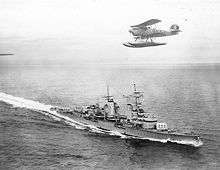Heinkel He 60
| He 60 | |
|---|---|
 | |
| Heinkel He 60. | |
| Role | Reconnaissance Seaplane |
| Manufacturer | Heinkel |
| First flight | Early 1933 |
| Introduction | 1933 |
| Retired | 1943 |
| Primary users | Luftwaffe Kriegsmarine |
|
| |
The Heinkel He 60 was a German single-engined biplane reconnaissance seaplane designed to be catapulted from Kriegsmarine (German navy) warships of the 1930s.
Development and design
The Heinkel He 60 was designed by Heinkel engineer Reinhold Mewes, the designer of the He 59.[1] The resulting design was a single-engined biplane of mixed wood and metal construction with fabric covering. Its single bay wings were of equal-span and had significant stagger.[2]
The first prototype flew early in 1933 and proved to be underpowered with its 492 kW (660 hp) BMW VI engine. The second prototype had a more powerful version of the BMW engine, but this only marginally improved its performance and was unreliable, so production aircraft reverted to the original engine.[2][3] Of conventional configuration, the He 60 was a sturdy aircraft, designed (as the specification required) to be capable of operating on the open sea. As a result, it was always somewhat underpowered for its weight, which made handling sluggish and the aircraft vulnerable to enemy fire. Attempts were made to solve its lack of power by fitting one aircraft with a Daimler-Benz DB 600 engine, but engines were not available for production.[4]
Operational history

Initial deliveries of the He 60 were to Kriegsmarine training units in June 1933.[4] From 1934, the major production version, the He 60C began to be delivered to the shipboard floatplane units of the Kriegsmarine, operating from the catapults of all German cruisers.[5] It also saw action with Spanish Nationalist forces during the Civil War.[1]
In 1939 it was replaced as a shipboard aircraft first by the He 114 in service, then soon after by the Arado Ar 196, but it remained in service with several coast reconnaissance Staffeln (squadrons) when World War II began.[6] It had been withdrawn from front-line service by 1940, but returned to use following Germany's invasion of the Soviet Union in 1941, being used for coastal patrol work in the Baltic and Mediterranean Seas. All He 60s were removed from service by October 1943.[1]
Variants
- He 60a
- First prototype which began flight testing in early 1933.
- He 60b
- Second prototype which experimented with a more powerful engine. However, it proved no better and the design reverted to that used in the 60a.
- He 60c
- Third prototype, used for successful catapult trials in early 1933. This aircraft was delivered into operational service with the navy.
- He 60A
- 14 pre-production aircraft were ordered. A total of 81 A-variant aircraft were produced.
- He 60B
- Initial production version, commencing in 1934.
- He 60B-3
- In 1933 a single aircraft was fitted with a 671 kW (900 hp) Daimler-Benz DB 600 engine in an effort to improve performance. However, the development was dropped.
- He 60C
- In late summer 1934, the improved C-variant went into production, with first deliveries in Autumn 1934.
- He 60D
- The D-variant was similar to the He 60C, with the capability added for a fixed MG-17 machine gun and improved radio equipment. Production commenced in June 1936.
- He 60E
- 6 aircraft were ordered by Spain, and these D-variants were called the 60E, ending delivery in April 1937. They flew coastal patrols in the Spanish Civil War, and the last aircraft were withdrawn from service in 1948.
Operators
- Bulgarian Navy - 5 examples from 1942-1944
Specifications (He 60)
Data from War Planes of the Second World War: Volume Six Floatplanes [5]
General characteristics
- Crew: two (pilot and observer)
- Length: 11.50 m (37 ft 8¾ in)
- Wingspan: 13.50 m (44 ft 3¾ in)
- Height: 5.30 m (17 ft 4¾ in)
- Wing area: 56.0 m² (603 ft²)
- Empty weight: 2,735 kg (6,018 lb)
- Loaded weight: 3,407 kg (7,495 lb)
- Powerplant: 1 × BMW VI 6.0 water-cooled V12 engine, 492 kW (660 hp)
Performance
- Maximum speed: 240 km/h (130 knots, 149 mph) at sea level
- Cruise speed: 216 km/h (117 knots, 134 mph)
- Range: 826 km (446 nmi, 513 mi) at 2,000 m (6,560 ft)
- Service ceiling: 5,000 m (16,400 ft)
- Climb to 1,000 m (3,280 ft): 3.2 min
Armament
- Guns: 1 × 7.92 mm (.312 in) MG 15 machine gun in flexible mount for observer
See also
- Related lists
- List of aircraft of World War II
- List of World War II military aircraft of Germany
- List of military aircraft of Germany
References
| Wikimedia Commons has media related to Heinkel He 60. |
- Notes
- Bibliography
- Donald, David (editor). Warplanes of the Luftwaffe. London:Aerospace Publishing, 1994. ISBN 1-874023-56-5.
- Green, William. War Planes of the Second World War: Volume Six Floatplanes. London:Macdonald 1962.
- Smith, J.R. and Kay, Antony L. German Aircraft of the Second World War. London:Putnam, 1972. ISBN 0-85177-920-4.
- Lang, Gerhard. The Heinkel HE 60 (Luftwaffe Profile). Schiffer Publishing, 2004. ISBN 0-88740-922-9